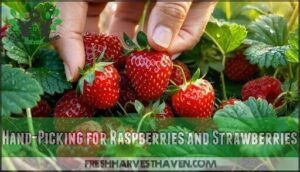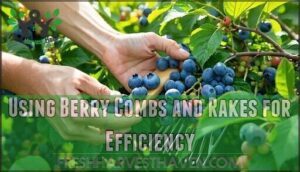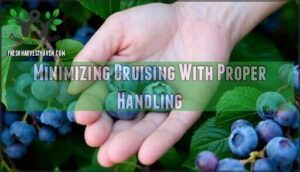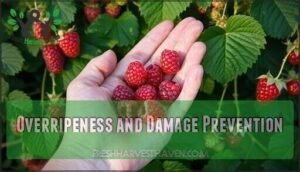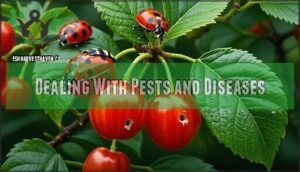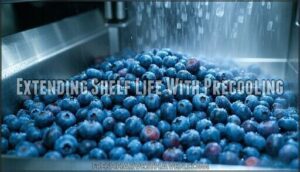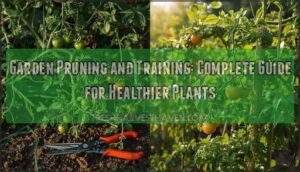This site is supported by our readers. We may earn a commission, at no cost to you, if you purchase through links.
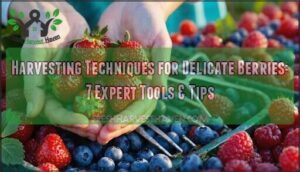
You’ll reduce bruising by 40% compared to midday picking. Look for ripeness indicators: bright red strawberries with sweet aroma, deep blue blueberries that detach easily, and richly colored raspberries separating cleanly from stems.
Use specialized tools like berry picker rakes to increase speed by 300% and gentle hand-picking for softest varieties. Handle berries with care, supporting from underneath to prevent cellular damage.
Cool harvested berries immediately and store unwashed at 34-38°F with high humidity to double shelf life. The right combination of timing, tools, and technique transforms your berry harvest from bruised disappointment to perfect treasure with gentle hand-picking.
Table Of Contents
- Key Takeaways
- Optimal Harvesting Times for Delicate Berries
- Post-Harvest Handling and Storage Tips
- Top 7 Tools for Harvesting Delicate Berries
- Gentle Harvesting Techniques for Berries
- Selecting and Caring for Berry Varieties
- Troubleshooting Common Harvesting Issues
- Frequently Asked Questions (FAQs)
- How do you harvest common types of berries?
- Do berries need a manual harvest?
- How should berries be handled after harvest?
- How do you pick ripe berries?
- What is berry harvesting?
- How often should berries be harvested?
- What do you soak berries in to get the worms out?
- How long do berries need to dry after washing?
- How to pick berries efficiently?
- Whats the best weather for berry picking?
- Conclusion
Key Takeaways
- Time your harvest perfectly – Pick berries during cool morning hours after the dew dries but before the heat sets in to reduce bruising by 40% compared to midday picking.
- Use specialized tools for efficiency – Berry picker rakes increase harvesting speed by 300%, while gentle hand-picking tools and nitrile gloves protect delicate varieties from damage.
- Handle berries like precious cargo – Support berries from underneath during picking and transfer them immediately to shallow containers to prevent cellular damage and bruising.
- Cool and store properly for maximum shelf life – Immediately cool harvested berries to 34-38°F with high humidity and avoid washing until consumption to double their shelf life.
Optimal Harvesting Times for Delicate Berries
You’ll want to hit the berry patch right after the morning dew dries but before the sun heats things up.
This sweet spot gives you the firmest berries that won’t turn to mush in your basket.
Cool Morning Hours for Firmness
The early bird catches the worm—and you’ll catch the firmest berries.
Cool morning hours maintain berry firmness by reducing respiration rates, keeping cellular integrity intact.
Cool mornings lock in berry firmness—your harvest window for perfect fruit
Harvest when temperatures stay between 50-65°F for ideal results.
Pick after dew dries but before heat sets in, typically 1-2 hours post-sunrise.
This timing prevents the 40% bruising increase seen in midday picking, which is a critical factor to consider for optimal berry quality and to get the best results.
Fully Ripe Indicators by Berry Type
Timing’s just the beginning – knowing exactly when each berry’s ready makes all the difference.
Different berries show distinct ripeness indicators, and you’ll want to master these visual and tactile cues for ideal harvest time.
- Strawberries: Bright red color with sweet aroma and green calyx
- Blueberries: Deep blue with matte finish, detach easily when tugged
- Raspberries: Rich raspberry color, separate cleanly from receptacle
- Blackberries: Intense black with dull finish, slight blackberry softness
Berry firmness varies by type, but ripe berries should feel substantial without being rock-hard.
Trust your senses – proper berry ripeness indicators include color depth, gentle give, and that telltale fragrance signaling peak flavor.
Understanding gentle harvesting techniques is vital for maintaining the quality of delicate berries during the harvesting process.
Frequency of Harvesting Every 2–3 Days
You’ll want to check your berry patches consistently to capture peak fruit quality and maximize your berry yield.
Regular harvest scheduling prevents overripeness and maintains prime fruit quality through frequent picking.
| Berry Type | Picking Frequency | Peak Harvest Window |
|---|---|---|
| Strawberries | Every 2-3 days | 4-6 weeks after flowering |
| Raspberries | Every 2 days | Mid to late summer |
| Blueberries | Every 3-4 days | 2-3 months harvest season |
| Blackberries | Every 2-3 days | Late summer peak |
| Currants | Every 3-5 days | Mid-summer concentrated harvest |
Consistent berry harvesting techniques guarantee you’re always working with the freshest fruit. This delicate berry picking approach prevents losses from overripe berries that attract pests or fall naturally.
Your berry harvesting schedule becomes second nature once you establish these berry ripeness indicators as your guide, ensuring a successful and maximize your berry yield with the right techniques.
Post-Dew, Pre-Heat Timing
You’ll capture peak Morning Firmness by timing your harvest perfectly.
Wait until dew evaporates but beat the rising heat – this sweet spot delivers Ideal Sweetness with Reduced Moisture content.
Cool morning hours provide ideal conditions for gentle harvesting methods, ensuring Bruising Prevention and Extended Freshness.
This harvesting timing strategy maximizes your delicate berry picking success.
Post-Harvest Handling and Storage Tips
You’ve just picked your precious berries, but your work isn’t done yet.
Proper post-harvest handling can double your berries’ shelf life and keep them tasting fresh for days longer than poor storage methods.
Rapid Cooling Methods for Freshness
Speed matters when harvesting berries—their clock starts ticking the moment they leave the plant.
Forced air cooling drops temperatures 75-90% faster than passive methods, while vacuum cooling works in minutes instead of hours.
When every minute counts, smart cooling techniques can save your entire berry harvest from spoilage
Hydrocooling isn’t ideal for soft berries since water contact promotes rot.
Precooling techniques like icing methods and rapid cooling systems can slash spoilage by up to 50%.
Effective post harvest cooling methods are essential for preserving delicate berries, and using the right technique can make a significant difference in maintaining their quality and extending their shelf life with proper handling.
Ideal Storage Conditions (34-38°F, 90-95% Humidity)
Once you’ve rapidly cooled your berries, proper Cooler Storage becomes your freshness lifeline.
Store berries at 34-38°F with 90-95% Humidity Control to prevent shriveling and mold growth. This temperature sweet spot slows respiration while maintaining berry integrity.
- Refrigerator Storage: Keep berries in crisper drawers with adjustable humidity settings
- Breathable Packaging: Use ventilated containers or clamshells for air circulation
- Berry Shelves: Position containers to avoid crushing from weight above
These berry storage conditions can double your Shelf Life Extension compared to room temperature storage.
Avoiding Washing Until Consumption
Keeping berries unwashed until consumption prevents berry moisture from accelerating fruit spoilage and mold growth.
This washing risks approach maintains berry quality preservation through careful fresh storage practices, protecting delicate berry handling investments you’ve made.
Proper storage temperature control is essential for extending the shelf life of harvested produce, including delicate berries.
| Berry Type | Shelf Life (Unwashed) | Spoilage Risk (Pre-Washed) |
|---|---|---|
| Strawberries | 5-7 days | 2-3 days |
| Raspberries | 3-5 days | 1-2 days |
| Blueberries | 7-10 days | 3-5 days |
| Blackberries | 3-5 days | 1-2 days |
Sorting and Packaging Best Practices
Sort through your berries like a pro by removing damaged, diseased, or unripe fruits during berry sorting and grading.
Use breathable packaging with ventilation holes for cool storage while maintaining moisture control.
Gentle handling prevents bruising—place berries directly into shallow containers rather than transferring multiple times.
These berry quality control measures and proper berry handling techniques preserve freshness during transport, ensuring the best results with proper berry handling.
Top 7 Tools for Harvesting Delicate Berries
You’ll need the right tools to harvest delicate berries without crushing or damaging them during picking.
These seven essential tools protect your berries from bruising while making the harvesting process faster and more efficient.
1. Berry Picker Rake Scoop Tool
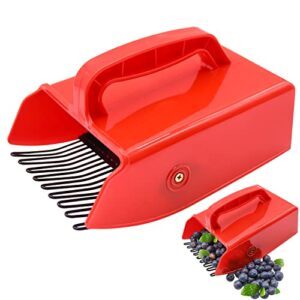
Why struggle with tiny berries when there’s a better way? The berry picker rake scoop tool features closely spaced tines that gently detach ripe berries while leaving unripe ones on the bush.
You’ll harvest 7-10 pounds per hour—that’s 300% faster than hand-picking. The lightweight design with ergonomic handle reduces fatigue, and the integrated container holds 800-900 blueberries.
Perfect for blueberries, lingonberries, and currants, though you’ll need to sort out some leaves afterward, making it a great tool for those who want to harvest quickly and efficiently, and the berry picker is ideal for this task.
Best For: Anyone who needs to harvest large quantities of small berries efficiently, especially those with physical limitations who want to avoid bending or extended hand-picking.
- Increases harvesting speed by 300% compared to hand-picking, allowing collection of 7-10 pounds per hour
- Lightweight ergonomic design with integrated container reduces fatigue and strain during extended use
- Gentle tines effectively separate ripe berries from unripe ones while minimizing damage to delicate fruit
- Collects unwanted plant material like leaves and twigs that require post-harvest sorting
- Some durability issues reported with units arriving broken during shipping
- Less effective on berry varieties with thick stems or widely spaced fruit placement
2. Linden Sweden Berry Picker Tool
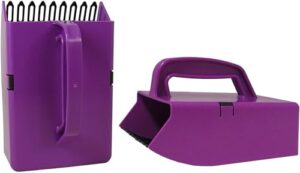
The Linden Sweden Berry Picker Tool makes berry gathering a breeze—think combing through bushes like a pro, minus the scratched hands.
Its lightweight, food-safe plastic scoop lets you pick blueberries and huckleberries up to three times faster than by hand.
The comfy handle keeps you going without wrist fatigue, and it’s dishwasher-safe for easy cleanup.
Just remember: gentle scooping keeps bruising low.
If you’re aiming for a full pie or jam jar, this tool’s your ticket to a bumper harvest with minimal fuss, making it ideal for a full pie.
Best For: Families, hobbyists, and U-Pick farm visitors who want to gather blueberries, huckleberries, and similar berries quickly and comfortably.
- Speeds up berry picking 2–3 times compared to hand-picking.
- Lightweight, ergonomic, and protects hands from thorns.
- Dishwasher-safe and made from food-safe, BPA-free plastic.
- Can bruise berries if used too forcefully or on overripe fruit.
- Not suitable for fragile berries like raspberries or strawberries.
- Requires regular cleaning to prevent residue buildup.
3. Fiskars Herb Garden Scissors Shears Snips
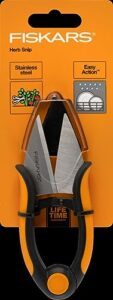
Precision is your best friend when harvesting delicate berries, and Fiskars Herb Garden Scissors Shears Snips deliver just that.
Their sharp, pointed blades let you snip stems cleanly, so you don’t bruise your fruit. The spring-action handles keep your hands from cramping, even after a long picking session.
Dishwasher-safe and rust-resistant, these snips are easy to clean—no sticky berry juice mess. If you want to avoid squishing berries and keep your harvest looking exceptional, these shears are a smart choice because they help you maintain delicate berries.
Best For: Gardeners and berry pickers who need precise, gentle cuts to avoid damaging delicate fruit and herbs.
- Sharp, pointed blades make clean snips, reducing bruising and spoilage.
- Spring-action design and soft-grip handle minimize hand fatigue during long sessions.
- Dishwasher-safe and rust-resistant for easy cleaning and durability.
- Small size may not suit larger pruning tasks.
- Lightweight design could feel flimsy for users who prefer sturdier tools.
- Locking mechanism may require extra care to avoid accidental blade exposure.
4. Heavy Duty Black Nitrile Gloves
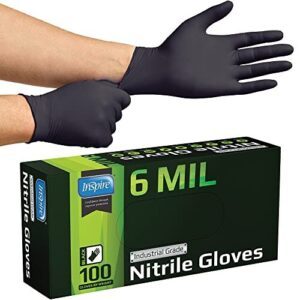
A berry picker’s best friend, heavy duty black nitrile gloves keep your hands safe from thorns and sticky sap, all while letting you feel for ripe fruit.
You’ll appreciate their textured grip—no more dropping berries in the dew! They’re tough enough for repeated use, yet sensitive enough for gentle picking.
Plus, they’re latex-free and food-safe, so you won’t worry about allergies or contamination.
Change them every couple hours to keep things clean, and stash a box in your basket for backup.
Proper handling techniques, including gentle harvesting methods, are essential for maintaining the quality of delicate berries.
Best For: Berry pickers, farm workers, and anyone needing durable, food-safe gloves for delicate harvesting tasks.
- Superior puncture and chemical resistance protects hands from thorns, sap, and berry acids.
- Textured fingertips provide excellent grip and tactile sensitivity for gentle fruit handling.
- Latex-free and certified food-safe, reducing allergy and contamination risks.
- Slightly snug fit may feel tight for some users, especially in smaller sizes.
- Disposable design creates waste, though recycling options are limited.
- Packaging quality can vary, with occasional box tears or damage reported.
5. Small Natural Fiber Berry Baskets
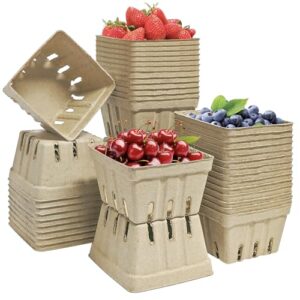
You’ll quickly see why small natural fiber berry baskets are a game-changer for delicate harvests.
Their breathable design keeps berries fresh and plump, while the shallow profile prevents squishing—no more sad, mushy fruit!
These baskets are sturdy, stackable, and eco-friendly, making cleanup a breeze.
Whether you’re picking for a picnic or prepping for market, you’ll appreciate how they minimize bruising and extend shelf life.
Plus, they’re perfect for gift baskets or decorative projects—just don’t be surprised if friends ask for extras!
Best For: Home gardeners, small-scale farmers, and anyone looking to keep delicate berries fresh and presentable for parties, markets, or gifting.
- Breathable design keeps berries fresh and reduces spoilage.
- Eco-friendly, compostable, and reusable for multiple harvests.
- Sturdy and stackable, easy to use for picking, storage, and display.
- Not waterproof; may lose shape if soaked or exposed to heavy moisture.
- Limited capacity due to shallow profile, not ideal for large harvests.
- May cost more upfront than single-use plastic containers.
6. Zenport Long Reach Fruit Picker
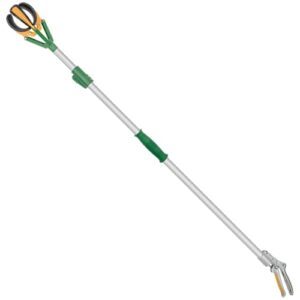
Reach for new heights in berry picking with the Zenport Long Reach Fruit Picker.
You’ll skip the ladder and grab berries from tall bushes without feeling like a circus performer.
The telescoping pole stretches up to 12 feet, while padded claws keep delicate fruit bruise-free.
Its lightweight aluminum build means less arm fatigue, and the cushioned basket design helps you avoid hand strain.
If you’ve ever lost a berry to a clumsy reach, this tool’s precision head saves your harvest—and your dignity.
Best For: Small-scale berry growers and home gardeners who need to safely pick high or hard-to-reach fruit without using a ladder.
- Telescoping pole extends up to 12 feet, allowing access to tall berry bushes and trees.
- Cushioned, padded claws and basket minimize bruising and damage to delicate fruit.
- Lightweight aluminum construction reduces fatigue and is easy to handle for extended periods.
- Slightly heavy when fully extended, which may be tiring for some users.
- Plastic parts can degrade if left in direct sunlight for long periods.
- Difficult to return if defective due to its length and shipping challenges.
7. Drip Depot Berry Picker Tool
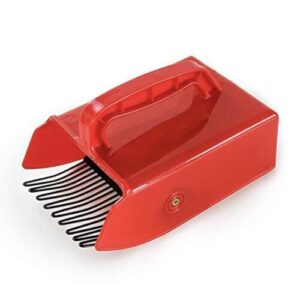
Ever found yourself juggling berries and battling thorns? The Drip Depot Berry Picker Tool makes life easier.
Its metallic comb gently sweeps berries from stems, protecting both fruit and plant. You’ll love the raised rim that keeps your harvest from spilling everywhere—no more chasing runaway blueberries!
Lightweight and ergonomic, it’s easy on your hands, even during marathon picking sessions. Cleaning’s a breeze, and it’s tough enough to last all season.
Whether you’re a backyard grower or a berry fanatic, this tool boosts your efficiency.
Best For: Home gardeners and berry enthusiasts who want faster, gentler picking without hand strain or berry damage.
- Ergonomic grip and lightweight build reduce hand fatigue during long picking sessions.
- Raised rim and metallic comb minimize berry spills and protect both fruit and plant.
- Easy to clean, durable, and adapts to various berry types and sizes.
- Not ideal for large commercial harvests due to its compact size.
- May require adjustment for very firm or unusually large berries.
- Initial learning curve for optimal use, especially with mixed berry patches.
Gentle Harvesting Techniques for Berries
When you’re picking delicate berries, you’ll want to use gentle techniques that protect their soft skins and keep them looking their best.
Whether you’re hand-picking raspberries or shaking tall branches for mulberries, a careful touch makes all the difference—no one wants a basket of berry jam before breakfast.
Hand-Picking for Raspberries and Strawberries
You’ll find hand-picking remains the gold standard for raspberries and strawberries since these delicate berries bruise easily.
Gentle plucking with your fingertips works best – ripe berries detach effortlessly when ready.
Focus on fruit ripeness indicators: strawberries should be bright red without green shoulders, while raspberries separate cleanly from their core.
This berry handling technique guarantees your handpicked berries stay perfect for market or table, following the best practice of gentle plucking and checking for ripe berries.
Using Berry Combs and Rakes for Efficiency
When you’re ready to pick smarter, not harder, berry combs and rake tools can boost your harvest efficiency by up to 50%.
These comb designs work best on blueberries, currants, and lingonberries, where flexible tines gently lift fruit without bruising.
Berry rakes with adjustable spacing adapt to different sizes, making your harvesting techniques more versatile across delicate berries.
Understanding proper berry comb usage is essential for maximizing yield.
Shaking Techniques for Tall Berry Plants
When berry combs won’t reach those towering mulberry or elderberry branches, shaking techniques become your best friend.
Position a clean tarp beneath tall berry plants, then gently shake branches using smooth, rhythmic motions.
This berry drop technique allows ripe fruit to fall naturally while preventing damage from climbing or stretching.
Use branch handling methods that protect both you and the plant’s structure.
Minimizing Bruising With Proper Handling
Proper handling during berry collection makes the difference between fresh fruit and mushy disappointment.
Use both hands when possible—one to steady the plant, another for gentle picking. Handle each berry like a soap bubble, supporting from underneath rather than squeezing.
Cool your harvest immediately in shade, then transfer to refrigeration within an hour to prevent cellular breakdown and extend shelf life.
Selecting and Caring for Berry Varieties
You’ll get the best harvests when you choose berry varieties that match your local growing conditions and resist common diseases.
Research proven varieties from nearby farms and nurseries, then focus on proper plant care after each harvest to guarantee healthy, productive plants for years to come.
Disease Resistance and Yield Expectations
Modern disease-resistant berry varieties can boost your yields by 15-20% while slashing fungicide costs up to $1,200 per acre.
You’ll find cultivars like ‘Legacy’ blueberries show 30% higher survival rates against mummy berry disease, while resistant strawberries deliver 25% greater yields under organic management.
However, some disease tolerance may trade off with fruit size or flavor characteristics.
Growers can benefit from understanding disease resistant techniques to improve their crop outcomes.
Climate and Soil Suitability
Your berry success depends heavily on matching varieties to your regional climate and soil types.
Cold-hardy blueberries thrive in acidic soils with pH 4.5-5.5, while strawberries prefer well-draining loam with neutral pH.
Test your soil quality before planting, and consider berry soil amendments like sulfur for pH adjustment or compost for drainage improvement.
Post-Harvest Plant Health Maintenance
After harvest, your plants deserve some TLC to bounce back strong.
Smart berry plant maintenance keeps your future harvests thriving through proper soil recovery and vigilant pest management.
Here’s your post-harvest plant health checklist:
- Soil Recovery – Apply compost to restore nutrient cycling and support root health
- Fungal Control – Remove fallen fruit and debris to prevent disease buildup
- Pest Management – Inspect for damage and treat affected areas promptly
Researching Proven Local Varieties
Why gamble with untested berry varieties when your local agricultural extension office has the answers?
Research proven local varieties through extension services, experienced growers, and regional nurseries to match your climate impact, soil quality, and regional pests.
Focus on berry variety selection with strong yield expectations, disease resistance, and specific characteristics that guarantee the best berry ripeness in your area, considering factors like climate impact.
Troubleshooting Common Harvesting Issues
Even experienced berry harvesters face challenges that can turn a perfect morning into a frustrating mess.
You’ll encounter overripe fruit, pest damage, and storage mishaps, but smart techniques can save your harvest and extend your berries’ shelf life.
Overripeness and Damage Prevention
Timing makes the difference between perfect berries and mushy disappointments.
Check your plants every 2-3 days during peak season—waiting too long turns prize fruit into compost material.
Use gentle handling techniques and harvest during cool morning hours to maximize berry shelf life while preventing fruit bruising and spoilage through careful damage control, ensuring complete concepts are applied to maintain fruit quality.
Dealing With Pests and Diseases
Pest invaders can wreck your berry harvest faster than you’d expect. Pest Control starts with pest damage identification – spotted wing drosophila leaves tiny holes, while aphids cause curled leaves.
Disease Management requires Integrated Tactics combining Organic Methods like beneficial insects with proper sanitation. Biological Solutions such as Trichogramma wasps reduce pest damage by 60%.
Choose varieties with disease resistance to minimize berry diseases naturally.
Extending Shelf Life With Precooling
Immediate precooling after harvest can double your berry storage life.
Use rapid cooling methods like forced-air cooling or refrigeration to quickly drop temperatures to 32-34°F.
This cooling technique slows respiration and prevents deterioration, which is crucial for maintaining berry quality, and proper postharvest handling with these precooling methods maintains berry quality far longer than room-temperature storage, by utilizing techniques like forced-air cooling.
Preserving Berries Through Canning and Freezing
After precooling, you’ll want to preserve your berry harvest for year-round enjoyment.
Canning safety requires water bath processing for 10-15 minutes, while freezing methods like flash freezing preserve 92% of vitamin C.
Choose preservation techniques that maintain berry handling standards:
- Freezing retains more nutrients – keeps 85-95% of antioxidants versus 75-80% for canning
- Proper storage duration matters – frozen berries last 12 months, canned varieties stay fresh for one year
- Smart berry packaging materials extend shelf life substantially with vacuum sealing.
Understanding canning recipes is vital for successful preservation and maintaining the quality of delicate berries.
Frequently Asked Questions (FAQs)
How do you harvest common types of berries?
Pick berries in cool morning hours when they’re fully ripe.
Look for rich colors and easy detachment.
For strawberries, harvest when bright red; blueberries when fully blue; raspberries when deep red.
Do berries need a manual harvest?
Most delicate berries absolutely require manual harvesting. You’ll find that strawberries, raspberries, and blackberries are too fragile for mechanical harvesting, which would crush their tender skins and reduce quality substantially.
How should berries be handled after harvest?
Like fragile treasures, your freshly picked berries need immediate care.
Cool them quickly to 34-38°F, store in shallow containers with good airflow, and don’t wash until you’re ready to eat them, as these steps are crucial for handling your freshly picked berries.
How do you pick ripe berries?
Wait until berries reach peak ripeness with vibrant color and sweet aroma.
Gently twist or roll them between your fingers—they’ll detach easily when ready.
Harvest during cool mornings for firmer fruit.
What is berry harvesting?
Berry harvesting involves collecting ripe fruits from berry plants at their peak sweetness and quality.
You’ll time the harvest carefully, using proper techniques and tools to minimize bruising while preserving freshness for storage or consumption, which is crucial for maintaining the berries’ overall quality.
How often should berries be harvested?
You’ll want to harvest your berries every 2-3 days during peak season.
This frequent picking prevents overripeness, reduces damage, and guarantees you’re catching them at their sweetest moment before they turn mushy.
What do you soak berries in to get the worms out?
Soak fresh berries in cool saltwater (1 tablespoon salt per cup water) for 10-15 minutes. This draws out hidden insects and larvae naturally. Rinse thoroughly afterward to remove salt residue completely.
How long do berries need to dry after washing?
Let berries air-dry for 10-15 minutes after washing, or gently pat them with paper towels. You’ll know they’re ready when surface moisture disappears and they feel slightly tacky to touch.
How to pick berries efficiently?
Ready to maximize your harvest?
Pick berries in cool morning hours when they’re firmest, use shallow containers to prevent crushing.
Harvest every 2-3 days to catch peak ripeness before overripe damage occurs.
Whats the best weather for berry picking?
Cool, dry mornings offer ideal berry-picking conditions. You’ll find firmer berries that won’t bruise easily when temperatures stay low and humidity remains manageable before heat sets in.
Conclusion
Practice makes perfect when mastering these harvesting techniques for delicate berries.
You’ll transform your berry picking from amateur fumbling to professional precision using proper timing, tools, and gentle handling methods.
Morning harvests, specialized equipment, and immediate cooling protect your berries from bruising and extend shelf life substantially.
Remember to pick frequently during peak season, handle berries like precious gems, and store them correctly.
These expert harvesting techniques for delicate berries guarantee maximum quality and yield from your garden investment.
- https://academic.oup.com/fqs/article/8090155
- https://royalsocietypublishing.org/doi/10.1098/rsta.2013.0307
- https://extension.psu.edu/post-harvest-berry-handling/
- https://www.agrivi.com/blog/pre-cooling-changes-the-face-of-post-harvest-management/
- https://semcoice.com/overview-post-harvest-cooling-methods/


